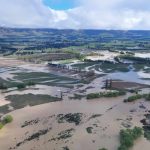
In short:
The biggest farm in Tasmania is up for sale with an expected price tag of more than $100 million.
Tasmania is still one of the most expensive states to buy agricultural land in Australia, with the median price per hectare more than double that of other parts of the country.
What’s next?
Rural property agents suggest renewable energy and carbon potential is increasing the value of land for prospective buyers of farmland.
Tasmania’s largest farm is back on the market and it’s expected to fetch offers of more than $100 million.
Rushy Lagoon is a sprawling 22,000-hectare property on the state’s north-eastern tip.
The late Allan Pye purchased the farm in 1996, snapping it up for $8 million at auction.
Mr Pye was one of New Zealand’s richest farmers, making his fortune in potatoes.
He passed away earlier this year and the sale is part of his estate.
The farm has run dairy, beef and sheep enterprises. (Supplied: RMS Advisory)
Peter Ryan from RMS Advisory is one of the agents handling the listing and said inquiries for the farm had been rolling in.
“Rushy Lagoon is an iconic property, not just in Tasmanian terms, but in Australian terms,” he said.
“Just about everybody who is anybody in agriculture has heard about the fabled Rushy Lagoon.
“We had a great deal of interest a few years ago, and interest is warming up today from parties who definitely have the wherewithal to make the purchase.”
Tasmanian farmland is in demand due to its reliable rainfall, access to irrigation schemes and productive soils; and increasingly its green credentials. (Supplied: RMS Advisory)
The farm has run dairy, beef and sheep enterprises, and has extensive irrigation.
The property was listed for sale in 2017, and expected to sell for $70 million but was later withdrawn from the market.
Since then, Rushy Lagoon has been slated for a multi-billion-dollar wind farm development.
“If the wind farm was to evolve, the rental paid by the wind farm operator would be significant income for the farm,” Mr Ryan said.
“I should stress the wind farm is no certainty, it’s more than a concept but let’s call it a plan.”
The land could eventually house a wind farm. (Supplied: RMS Advisory)
Green credentials boosting land values
Tasmanian farmland is some of the most expensive in Australia.
According to Rural Bank’s farmland values report released in May, the median price per hectare in the state is more than $20,000 a hectare.
That’s compared to the national median price of $9,500 per hectare.
Tasmanian agricultural land has long been much sought after, but is increasingly valuable for renewable energy potential. (Supplied: RMS Advisory)
Michael Warren, director of Nutrien Harcourts Tasmania said land prices were considerably higher in sought-after parts of the state.
“Your mixed-farming-type operations in the Northern Midlands is probably in excess of $40,000 a hectare, for those better-run properties with water.
“Good quality cropping ground with water is in that $40,000 to $60,000 [range] in the north-west.”
Tasmania’s Northern Midlands is a tightly-held district for cropping and grazing land. (ABC Rural: Laurissa Smith)
Historically, buyers are attracted to land in Tasmania due to its reliable rainfall, access to irrigation schemes and productive soils.
Mr Warren said they were still important attributes, but increasingly investors were looking at a farms’ potential for carbon and renewable energy projects.
“They might be reporting back to investor or shareholders, not only on a rate of return but these are the boxes they need to tick,” he said.
“There’s outside influences across the board now that perhaps we didn’t see five years ago.
“Whether a site has some suitability for renewable energy, whether it’s to sell into the broader grid or to offset energy use on an existing operation.
“People are mentioning to us about carbon audits and whether there’s been one done.”
The Woolnorth wind farm in Tasmania’s far north-west is one of five in the state. (ABC News: Piia Wirsu)
Woolnorth Dairy in the state’s far north-west is another iconic Tasmanian farm that’s also attracting wide buyer interest.
The last remaining chunk of what was once Australia’s largest dairy farm, was listed for sale by its Chinese billionaire owner in April this year.
Businessman Xianfeng Lu lost a large milk contract to supply new Zealand dairy giant Fonterra.
In 2016, he paid $280 million for Van Diemen’s Land Company and its dairies in Circular Head.
“There are a couple of wind farms up there and I would imagine that from some of the inquiries we’ve been getting that renewable energy of some sort will play a factor in the eventual sale purchase,” Mr Warren said.
“That’s that influence that’s appeared now in the market that wasn’t there perhaps 10 years ago and how things have changed.”
You can now read the most important #news on #eDairyNews #Whatsapp channels!!!
🇺🇸 eDairy News INGLÊS: https://whatsapp.com/channel/0029VaKsjzGDTkJyIN6hcP1K

























